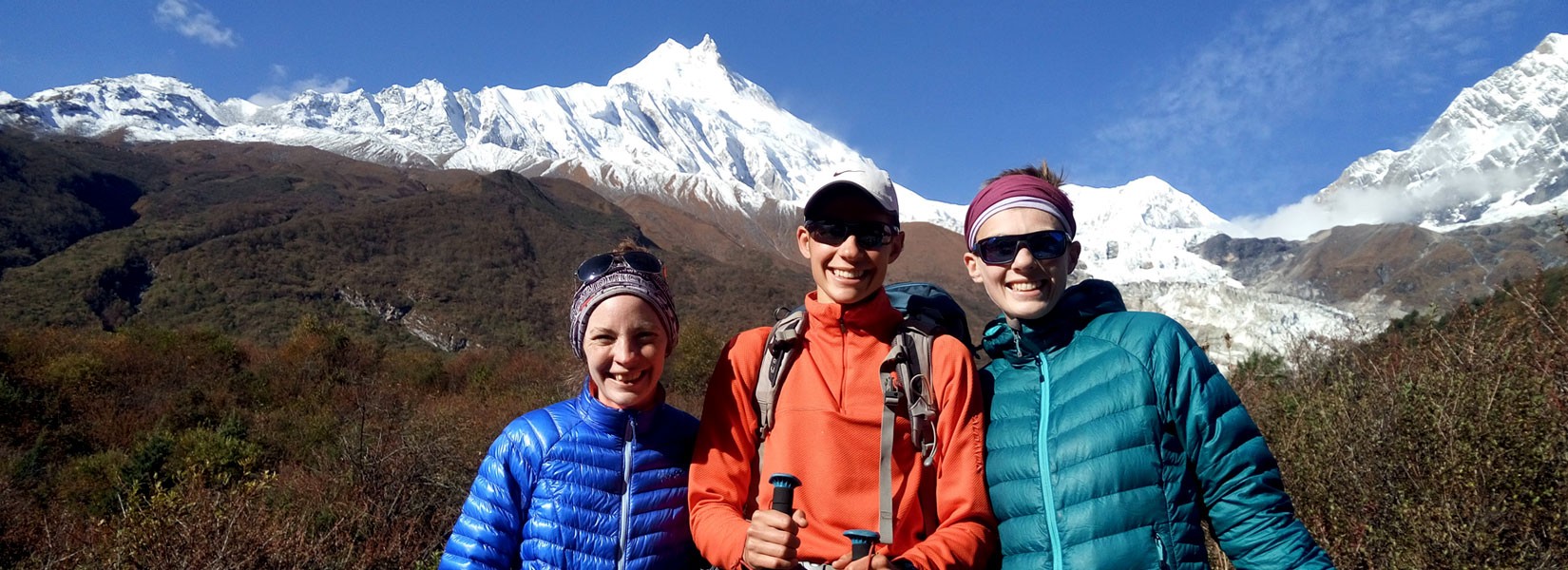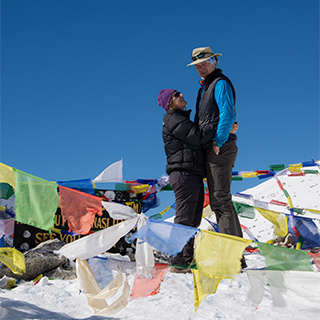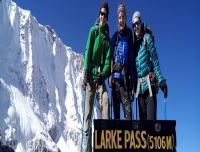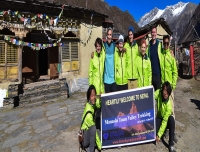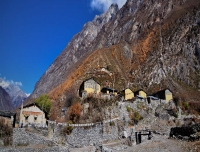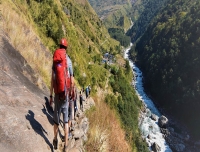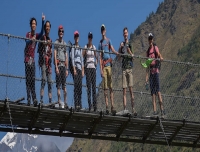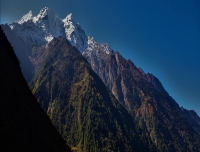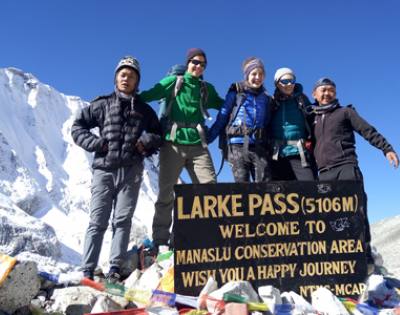- Read Reviews onTripadvisor
- Phone & WhatsApp Support+977 9851112535 (Chandra Shor)
Manaslu and Tsum Valley Trek via Larke Pass | 19 Days
Fact Information
- Duration
- 19 Days
- Destination
- Nepal
- Difficulty
- Moderate difficult
- Accommodation
- Hotel & Lodges
- Activity
- Trekking
- Transportation
- Tourist Bus, Car & Jeep
- Meals
- BLD (Breakfast, Lunch and Dinner)
- Max Person
- 15
- Min Person
- 2
- Maximum altitude
- [5,106 meters/16,752 ft]
- Best season
- September, October, November, April and May
About Trip
“An untouched beauty allows an opportunity to explore the total nature and mountain worth”
The Manaslu and Tsum Valley Trek takes you around the towering peak of Mt. Manaslu, the world’s eight highest Mountain, which rises to a height of 8,163 meters (26,781 ft), and through the hidden Shangri-La of Tsum Valley, which is a paradise for trekkers. This trek has become increasingly popular among wilderness explorers due to its stunning natural beauty and rich cultural experiences. The Manaslu trail was only opened to foreign trekkers in 1991, and the Tsum Valley was only opened in 2008, making this trek a relatively new and unspoiled destination.
Both the Manaslu and Tsum valleys are inhabited by Buddhist people of Tibetan origin, who settled here in the early 16th century. Their language, attire, and customs are resemble to those of Tibetans in northern Nepal. The views of the mountains in the Nup Ri region are sensational and iconic, and cannot be found anywhere else in the world. Tsum Valley is a sacred Himalayan pilgrimage site situated in the trans-Himalayan region of Gorkha, Nepal. Its unique combination of Tibetan culture, natural beauty, and pristine environment make it a truly unique destination.
The local people in Tsum Valley speak a unique dialect, and the trails are ornamented with artistic Chortens, monasteries, and mani walls made of thousands of stone slabs carved with deities and prayers. The valley has a rich history of Buddhism, and the Buddhist saint Milarepa is said to have meditated in the caves of the surrounding mountains. Traditionally, Tsum Valley was a culturally distinct area called 'Tsum Tso Chuksum', which means thirteen provinces ruled as a single territory. The ancient remains of the Tsum Kingdom are still visible today. Due to its remoteness and inaccessibility, this sacred valley and its people have been bypassed by mainstream development for centuries, preserving its unique culture and way of life.
The Tsum Valley is surrounded by the Buddha Himal and Himal Chuli to the west, Ganesh Himal to the south, and Shringi Himal to the north. The trip starts with an 8–9-hour bus journey from Kathmandu, covering approximately 141 kilometers along the Prithwi highway to Dhading Beshi. From there, the route separates to Gorkha, and we reach Arughat-Soti Khola through the Dhading Beshi route. Although the trip used to start from Arughat Bazar and end at Besisahar in the past, the new construction of a motor road means there is no fixed point to start or end.
On the second day of the journey, we follow the recently constructed gravel road along the Budhi Gandaki River to Manasalu-Larkye Sama Gau. The trail ascends continuously, passing through isolated Buddhist areas and biologically rich lands with magnificent mountain views. From the Dang hamlet, the trail passes through Tibetan-inhabited villages, and most of the local people are influenced by Tibetan culture, customs, and language. Along the way, we pass many mani walls, prayer stone walls, gompas, prayer flags, beautiful farmlands, lodges, and bridges. This trail rewards us with beautiful nature, culture, and a rejuvenating experience.
After 12 to 13 days of fabulous hiking, we reach Sama village, situated beneath the pinnacle of Mount Manaslu. It is a more touristic place in this remote area, with many wonderful side trips to explore, such as the Manaslu base camp, Pungent Gompa, Birendra Lake, and sightseeing of village and monastery.
Finally, we cross over the famous the Larkya La 5,106 meters (16,752 ft), moraine and glacier trail and descend to another Marsyangdi crystal river valley on the world’s famous Annapurna circuit Thorong La pass trail, and drive back to Besisahar- Kathmandu.
Trip Highlights
Mt. Manaslu: The trek takes you around the towering peak of Mt. Manaslu, the world’s eighth highest mountain.
Tsum Valley: The hidden Shangri-La of Tsum Valley is a paradise for trekkers, with its unique combination of Tibetan culture, natural beauty, and pristine environment.
Buddhist culture: The Manaslu and Tsum valleys are inhabited by Buddhist people of Tibetan origin, and their language, attire, and customs resemble those of Tibetans in northern Nepal.
Nup Ri region: The views of the mountains in the Nup Ri region are sensational and iconic, and cannot be found anywhere else in the world.
Monasteries and chortens: The trails are ornamented with artistic chortens, monasteries, and mani walls made of thousands of stone slabs carved with deities and prayers.
Milarepa's meditation caves: The Buddhist saint Milarepa is said to have meditated in the caves of the surrounding mountains.
Rich history: Tsum Valley has a rich history of Buddhism, and the ancient remains of the Tsum Kingdom are still visible today.
Larkya La pass: The trek involves crossing over the famous Larkya La pass, which is a challenging but rewarding experience.
Annapurna circuit: The trek concludes with a descent to another Marsyangdi crystal river valley on the world-famous Annapurna circuit Thorong La pass trail.
Outlined Itinerary
Day 01: Arrival in Kathmandu (TIA) 1,350m (4,429 ft), transfer to hotel include breakfast.
Day 02: Drive to Arughat, Gorkha, and Machhi Khola 930m (3,051 ft),10hrs.
Day 03: Trek from Machhikhola to Jagat 1,340 meters (4,396 ft), 7 to 8hrs.
Day 04: Trek from Jagat to Philim 1,570 meters (5,151 ft), 3 hours.
Day 05: Trek to Tsum valley, Chumling 2,386m (7828 ft), 8hrs.
Day 06: Trek from Chumling to Chhe Kamparo 3,011 meters (9,878 ft),75hrs.
Day 07: Trek from Chhekamparo to Nile 3,361 meters (11,027 ft), 5hrs.
Day 08: Visit Mu gompa and head back to Chhe Kamparo 3,011 m (9,878 ft), 3hrs.
Day 09: Trek back to Lokpa 2,240 meters (7,349 ft), 8 hours.
Day 10: Exit from Tsun valley, trek to Dang 1,860m (6'102 ft), 8hrs.
Day 11: Trek from Dang to Namrung 2,630m (8,628ft), 7 hours.
Day 12: Trek from Namrung to Syala gau 3,500 meters (11,483 ft), 7-8hrs.
Day 13: Side trip to Pungyen 4,000 m (3,123 ft), Sama gau 3,520m (11,546 ft).
Day 14: Trek from Sama to Samdo 3,875 meters (12,713 ft), 3 to 4 hours.
Day 15: Trek from Samdo to Dharmsala 4,460 meters (14,632 ft), 4 hours.
Day 16: Cross Larkya Pass 5,106m (16,752 ft), Vimthang 3,590 m (11,778 ft) 9hrs.
Day 17: Trek down to Dharapani 1,963 meters (6,440 ft), 9 hours.
Day 18: Drive to Besisahar 820m (2,690 ft), Kathmandu1,350m (4,429 ft), 10hrs.
Day 19: Full day Sightseeing of UNESCO world heritage sites.
Day 20: Departure for home.
Detailed Itinerary
Day 01: Arrival in Kathmandu Airport 1,350 meters (4,429 ft), transfers to hotel.
Accommodation: 3 to 5 Stars standard of hotel .
Transportation: Tourist bus or car.
Meals: Welcome Dinner, Breakfast, and includes drinks.
Representatives from Himalayan Diamond Adventures will greet you upon your arrival at Tribhuvan International Airport in Kathmandu. You will be welcomed with a fresh flower garland, a traditional Nepali greeting, and then escorted to the hotel for bed and breakfast service. The drive from the airport to the hotel takes approximately 15 to 20 minutes, if there is no traffic jam on our way. After checking into the hotel, we will have a short refreshment meeting at the hotel. In the evening, the company will host a welcome dinner at a traditional Nepali restaurant, complete with a cultural dance performance, to celebrate the start of your trip. During the dinner, your guide will provide a brief overview of the schedule for the following day.
Day 02: Scenic bus journey to Arughat Bazar Gorkha and Machhi Khola:
Maximum elevation: 930m (3,051 ft).
Driving hours: 10 to 11 hours, about 150km.
Accommodation: Lodge.
Meals: Breakfast, Lunch & Dinner with hot drinks.
The journey from Kathmandu to Machhi Khola takes about 10 to 11 hours by private vehicle. To avoid traffic in Kathmandu, we should check out of our hotel before sunrise. At the beginning of our bus journey, we will drive on the busy Prithiwi Highway until Abukhaireni Gorkha Rajmarga, where a rough road connects to Arughat or Machhi Khola. Alternatively, we may cross the Trisuli River on the Dhading Bridge and continue on the Dhading Besi road, which links to the Arughat road that is still under construction. During the bus journey, we will pass through numerous villages, cultivated lands, rivers, waterfalls, and subtropical forests, offering views of majestic peaks such as Manaslu, Ngadi Chuli, Himal Chuli, Rani Peak, Baudha Himal, and Ganesh.
Day 03: Trek to Jagat following the Budhi Gandaki up River:
Maximum elevation: 1,340 meters (4,396 ft).
Trekking duration: 7-8hrs, ascent, 410m.
Accommodation: Lodge.
Meals: Breakfast, Lunch & Dinner with hot drinks.
On the first day of our trek, we will walk along the newly constructed motorable road that follows the Budhi Gandaki River. The trek will take around 7 to 8 hours for normal trekkers from Machhi Khola to Jagat. As we leave Machhi Khola, we will enter a giant gorge and the trail will be rocky until Dovan. The off-road section is still under construction, so we will walk most of the time along a raw trail. During the day, our trail will pass by beautiful waterfalls, tributaries, green forests, well-made suspension and wall-attached bridges, terraced lands, and tea houses.
Day 04: Pleasant trip to Chisapani:
Maximum 1,600m (5,249 ft).
Trekking duration: 4hrs, ascent 260m.
Accommodation: Lodge.
Meals: Breakfast, Lunch & Dinner with hot drinks.
Today, we will have a pleasant day. It is a 3 to 4 hour walk for the normal trekkers. The trail gradually ascends following the Budhi Gandaki River through Gurung villages with captivating views of Shringi Himal and farmlands. After walking for a while, we will cross a well-made suspension bridge over the Budhi Gandaki River, followed by a short climb up to Phillim village. This is a perfect place to stop for a cup of tea and refreshments before reaching our lunch spot in Chisapani.
Day 05: Today the trail links Tsum valley:
Maximum elevation: 2,386m (7,828 ft).
Trekking duration: 8hrs, ascent 780m, descent 200m.
Accommodation: T-house.
Meals: Breakfast, Lunch & Dinner with hot drinks.
Today, we will be walking through the gorge for about 7 to 8 hours. The trail begins with about an hour of walking on the Manaslu Larke La pass trekking trail before entering the Tsum Valley, which is a less touristic area. The Tsum trail starts with a slight ascent through pine wooded hills, which provide shade from the giant hill. After a short walk in the lush green forest, we will reach Lokpa, where there are two T-houses for trekkers to stop for a hot lunch. After lunch, we will continue walking through the jungle following the Sarti gorge, and our trail will steeply rise up, crossing a long bridge attached to the wall, offering beautiful views of the Sirya sparkling river. At the end of the day, our trail will drop to Sirya river, where we will cross a well-made suspension bridge before steeply climbing uphill to reach Chumling.
Trek to Chumling 2,386m (6,692ft):
Maximum elevation: Trek to Chumling 2,386m (6,692ft):
Trekking duration: 8hrs, ascent 780m, descent 200m.
Accommodation: T-house.
Meals: Breakfast, Lunch & Dinner with hot drinks.
After breakfast, we will start walking from Lokpa tiny Village which one is surrounded by geen lush forest, the entrance to the wild route leading to Tsum Valley. On a clear day, trekkers can enjoy stunning views of Baudha Himal (6672m) and Ganesh Himal VI while walking from Lokpa to Chumling. Our trail will first descend to the Lungwa River valley and then climb up through a dense subtropical forest of rhododendron and pine. There are no villages on the way between Lokpa and Chumling. We will be crossing the Syar Khola river to arrive at the village of Chumling. A side trip to the upper parts of Chumling will take us to a monastery from where we can catch great views of Ganesh Himal. Chumling has a health post and three monasteries - Panago Gumba, Mani Dhungyur, and Gurwa Gumba. is correct sentences?
Day 06: Trek to Chhe Kamparo 3,010 m (9,875 ft) Buddhist village:
Maximum elevation: 3,011m (9,878 ft).
Trekking duration: 4 to 5 hours, ascent 625m.
Accommodation: T-house.
Meals: Breakfast, Lunch & Dinner with hot drinks.
After breakfast, we checked out of the T-house and set off for Chhe Kampar, a culturally fascinating and mountain-blessed Buddhist village that takes about 5 hours to reach for normal trekkers. We began our day with a walk along a straight and deep valley Syar Khola, before gradually climbing uphill through several Buddhist Domje villages. Along the way, we passed cultivated lands, crossed bridges with gorgeous views, and finally made our way up steep paths through a light pine forest to reach Chhe Kampar, the best viewpoint of the Ganesh Himal and Himalachuli.
Day 07: Trek to Nile 3,361m. throughout the highlighted Buddhist lands:
Maximum elevation: 3,361m.
Trekking duration: 4 hours, ascent 350m
Accommodation Lodge.
Meals: Breakfast, Lunch & Dinner with hot drinks.
Today, we took a straight walk-through various Buddhist shrine places along the Sirya Khola river, enjoying the wide and beautiful landscapes. Throughout the day, we were treated to substantial views of the Ganesh Himal Mountain range, which takes the shape of the god Ganesh. Our journey today passed through many large villages, cultivated lands, and landmarks such as the longest mani walls, stupas, gompas, the Milarepa cave, and the popular Rachen Aani Gompa, all set against an awesome backdrop of the mountains. After about 4 hours of trekking, we reached Nile Lodge.
Day 08: Visit ancient Mu Gompa:
Maximum elevation: 3,700m ( 12,139 ft).
Trekking duration: 6-7hrs, 360m, descent 689m.
Accommodation: T-house.
Breakfast, Lunch & Dinner with hot drinks.
After our usual breakfast, we set off for the ancient Buddhist Mu Gompa, which lies along the historic Nepal and Tibet trade route, and plan to return to Nile for lunch. The hike is paradise-like, with stunning views along the way. After lunch, we trek back to Chhekamparo via the same path, taking in the splendid scenery once again.
Day 09: Trek back to Lokpa:
Maximum elevation: 2,240m (7,349 ft).
Trekking duration: 8 hours.
Accommodation: Lodge.
Meals: Breakfast, Lunch & Dinner with hot drinks.
After visiting the truly fascinating ancient Tibetan Buddhist sacred landmark, we trek back to Lokpa via the same path we took before. Today, we will be walking downhill for about 9 hours.
Day 10: We exit from Tsum and head off Manaslu Larkye La pass:
Maximum elevation: 1,860m (6'102 ft).
Trekking duration:8 hours.
Accommodation: T-house.
Meals: Breakfast, Lunch & Dinner with hot drinks.
This morning, we continued our trekking by linking up with the Manaslu Larkye La pass route after completing 5 days of unbeatable trekking in Tsum Valley. After our regular morning breakfast, we trekked down to the new bridge via the same route we took before. Today, our trail joins the Manaslu Larkye La pass trekking route before crossing the new bridge. Throughout the day, we trekked through a giant gorge with jungle shades, following the Budhi Gandaki river. After about 4 to 5 hours of slightly uphill walking, we reached Dyang, where we stopped over at one of the two T-houses in the area.
Day 11: Trek to Namrung through the Buddhist farmlands:
Maximum elevation: 2,630 meters (8,628 ft).
Trekking duration: 7-8hrs.
Accommodation Lodge.
Meals: Breakfast, Lunch & Dinner.
Today, we will trek to Namrung village through a narrow valley, which typically takes 7 to 8 hours for normal trekkers. After taking a short walk from the lodge, we will cross a suspension bridge over the Budhi Gandaki River. From there, the trail rises uphill and then drops to a tributary, eventually reaching Bihi Phedi. Our journey then continues straight to the Gap village through fascinating Buddhist lands. We will take a break at the Gap village for a hot lunch and refreshments. After lunch, we will continue our trek through cultivated lands and green forests, eventually steeply ascending to Namrung by the end of the day.
Day 12: Trek to Syala through the fascinating Buddhist lands:
Maximum elevation: 3,500m (11,483 ft).
Trekking duration: 8hrs, ascent 870m.
Accommodation: Lodge.
Meals: Breakfast, Lunch & Dinner.
Today, we will embark on a trek through some of the most culturally and naturally beautiful Tibetan Buddhist lands, offering iconic views of Mount Manaslu and other majestic mountains such as Rani Peak, Himal Chuli, and Ngadi Chuli. Along the way, we will pass through beautiful villages, mani walls, monasteries, cultivated lands, and jungle, all while taking in the breathtaking scenery. After approximately 7 to 8 hours of gentle uphill trekking, we will reach Syala village. Situated below Mount Manaslu, Syala was once a Yak grazing land and is now a popular destination for tourists seeking the best viewpoint of Manaslu.
Day 13: Side trip of Pung Gyen gompa 4,000m (3,123 ft), head off Samagau:
Maximum elevation: 3,520m, (11,546 ft).
Trekking duration: 6-7hrs, ascent 500m, descent 480m.
Accommodation: Lodge.
Meals: Breakfast, Lunch & Dinner with hot drinks:
Today, we will embark on a hike to Pung Gyen Gompa, a paradise-like flat meadow situated beneath the towering Mt. Manaslu and the Himala Chuli peak. The hike typically takes 2 to 3 hours for normal trekkers, and along the way, we will see the Pung Gyen glacier linking the wide meadow. The area is surrounded by majestic mountains such as Himal Chuli, Ngadi Chuli (Peak 19), and Manaslu, and is used as a grazing land for yaks, sheep, and horses during the summer. At the end of the place, there is a beautiful monastery that was unfortunately destroyed by an avalanche in 1953. After taking in the wonderful moment in this paradise-like setting, we will trek down to Sama Gaun, a more touristic place in this remote area that is naturally and culturally beautiful. Here, we can find luxurious lodges with WIFI service.
Day 14: Side trip of Manaslu Base Camp, trek towards Samdo:
Maximum elevation: 3,875m (12,713 ft).
Trekking duration: 8 hours, ascent 1,235m, descent 700m.
Accommodation: Lodge.
Meals: Breakfast, Lunch & Dinner with hot drinks.
At the first light of the sun, we check out of our lodge and head towards the Manaslu Base Camp. After a short walk, the route separates from the Samdo-Larkye Pass and gradually starts to steepen. Although it is difficult with steep climbing and high altitude, the backdrop views are spellbinding, and the Manaslu Glacier Lake and Base Camp are the highlights of the hike. It takes approximately 3 to 4 hours for normal pace trekkers to reach the Base Camp. After taking in the views, we will hike back down to Samdo village, which will take around 7 to 8 hours in total
Day 15: Trek to Dharmasala:
Maximum Elevation: 4,460m (14,632 ft).
Trekking duration: 3-4 hours, ascent 585m.
Accommodation: T-house.
Meals: Breakfast, Lunch & Dinner with hot drinks.
oday is an easy day, with a trek of 3 to 4 hours for normal pace trekkers. If the weather is favorable, we will be able to enjoy magnificent views of the Himalaya vistas. We start by walking straight way along the ancient Tibet and nepal trade route, then the trail rises as we cross a wooden bridge over a tributary. The trail ascends uphill through old Mani walls. Most of the trail today is gentle uphill through tundra, juniper, and Yak pasture lands. After walking halfway, we reach a viewpoint where we can see the magnificent Samdo peak in our backward, as well as Manaslu north, Nieke peak, and some neighboring peaks with eye-catching glacier views. We may even spot Bharal (blue sheep) if we are lucky. Finally, we will reach Dharmasala, where we will spend the night.
Day 16: Make a trek over the Larkya Pass 5,106 meters (16,752 ft):
Maximum elevation: 3,590m (11,778 ft).
Trekking duration: 7-8hrs, ascent 646m descent 1,516m.
Accommodation: Lodge.
Meals: Breakfast, Lunch & Dinner with hot drinks.
Today is considered the toughest day for trekkers on this route. The trail leads over the breathtaking Larkye La pass, which stands at 5,106m (16,752 ft) and involves passing along a long moraine and glacier trail. Trekking on the moraine can be a continuous slog for 3 to 4 hours until reaching the pass. It is important to start the high pass trek before sunrise to ensure safe passage, as being late on the pass can result in facing snowstorms or strong cold winds during the snowfall season. The trail gradually ascends to the top from the beginning to the end of the pass, which is marked with signboards, rock cairns, and prayer flags. The Larkye La pass offers exhilarating mountain views, including Himlung, Cheo, Gyajung Khang, Kangaroo, and Annapurna II, which can be seen excellently in front of us. After crossing the pass, the trail drops steeply to Vimthang, making for a long walk downhill on a rugged trail.
Day 17: Trek down to Dharapani, links Annapurna circuit trail
Maximum elevation: 1,963 meters (6,440 ft).
Trekking duration: 8-9hrs, descent 1,627m.
Accommodation: Lodge.
Meals: Breakfast, Lunch & Dinner with hot drinks.
Leaving Vimthang, the trail descends several times to ethnic groups villages, such as Gho, Tilche, and Dharapani, passing through rhododendron and past ancient silver pine forests and rhododendron forest with remarkable views of Manaslu North and Ngadi Chuli, as well as the crystal pristine Dhudk Khola river. In April and May, the rhododendron flowers bloom and add splashes of pleasant color to the entire forest at this altitude, making for an enjoyable trekking experience. After passing through the rhododendron forest, we walk on the newly opened motor-able road with beautiful scenery. The trail passes through well-made suspension bridges, beautiful villages, cultivated farmlands, and follows the Dudh Khola downstream throughout the day. Finally, we cross a well-made suspension bridge over the Marsyangdi River to join the Dharapani Annapurna circuit route
Day 18: Drive back to Kathmandu 1,350m (4,429 ft) through Besisahar.
Accommodation: 3 to 5 stars hotel.
Driving hours: 10-11hrs by private vehicle.
Meals: Breakfast, Lunch & Farewell dinner.
After trekking for 14 days on the off-beaten trail, including Tsum and Manaslu-Larke Pass, we will ride back to Kathmandu today. The journey takes about 10 to 11 hours by private jeep or tourist bus. In the first stage, we will ride on the off-road, then from Besi Shahar to Dumre on the pitched road following the Marsyandi river. After driving halfway, our road will connect with the Prithvi highway. During the ride, we will cross many beautiful terraced fields, cities, villages, cultivated lands, waterfalls, and rivers.
Day 19: Full day Sightseeing of UNESCO world heritage sites:
Accommodation: Hotel.
Maximum elevation: 1,350m (4,429 ft).
Transportation: Private vehicle.
Meals: Breakfast with the buffet system.
Today, we are going to do a Kathmandu valley sightseeing tour. As the historical and cultural heart of Nepal, Kathmandu is a popular destination for tourists, trekkers, and adventure seekers. The city offers a wonderful blend of Hinduism, Tibetan Buddhism, and Western influence. Its major neighboring cities, Patan and Bhaktapur, also hold immense historical, cultural, and religious significance. Our half-day guided tour will take us to the famous and biggest Hindu shrine, Pashupatinath temple, the largest Buddhist stupa in town, Boudhanath, the 15th-century palace of 55 windows, Bhaktapur, and Swayambhunath stupa. In the evening, there will be a farewell dinner.
Day 20: Departure for home:
Meals: Breakfast with the buffet system.
Transportation: Private vehicle.
We will drop you off at the terminal room of Tribhuvan International Airport in time for your flight check-in. You can choose to take a tourist bus or a car for your transfer. It was great having you with us, and we wish you a safe and pleasant journey. See you off!
Note: that the outlined itinerary is designed for those who prefer a full package service. However, we understand that preferences and time constraints may vary, so we offer the flexibility to customize the itinerary according to your needs. The selection of itineraries and staff will be based on your specific requirements and budget. Additionally, we have options available for partial visits to accommodate your preferences and financial situation.
Cost Details
What's included
- 1. Airport pickup and drop-off by a private vehicle as per your itinerary.
- 2. Three nights of deluxe accommodation with a shared room at Hotel Moonlight or a Kathmandu Guest House in Thamel, Kathmandu, including breakfast.
- 3. Transportation: Private tourist bus from Kathmandu to Machhikhola and Dharapani to Kathmandu.
- 4. The menu is based on the client's choice, offering three meals a day (breakfast, lunch, dinner), along with fresh fruits and a selection of hot drinks, including tea, coffee, ginger lemon tea, ginger lemon honey, hot chocolate, milk tea, milk coffee, and hot water.
- 5. Tea-house accommodations during the trek, ensuring cleanliness and comfort.
- 6. Entry permit fees: Tsum valley special permit, Manaslu special permit, MCAP, and ACAP fees.
- 7. One-day valley sightseeing, which includes visits to Pashupatinath, Swayambhunath, and Boudhanath Stupa, with a city guide and transportation.
- 8. A highly experienced, helpful, knowledgeable, and friendly English-speaking guide with a government license, including all expenses for salary, food, drinks, accommodation, transport, and insurance.
- 9. Assistance guide service depends on the group size and quality.
- 10. Arrangement of Emergency Helicopter service, the cost of which will be covered by your Travel Insurance company.
- 11. One strong and helpful porter for every two members, equipped with proper gear, warm clothing, and necessary trekking equipment, such as Gore-Tex jacket/trousers, trekking shoes, woolen hat, woolen gloves, woolen socks, sunglasses, etc.
- 12. Nepalese staff's insurance policy covers emergency rescue evacuation by helicopter, hospitalization, medical treatment, and accidents.
- 13. Medical supplies, including a first aid kit, will be available.
- 14. Company's complimentary items: Duffle bag, map, and company T-shirt.
- 15. Hot bag services.
- 16. Government taxes and official expenses.
- 17. Entry fees for UNESCO heritage sites.
- 18. We provide rental services for down-filled jackets, sleeping bags, mini crampons, and trekking poles. There is an additional fee of $5 per day for laundry service and maintenance.
- 19. Oximeter to check your pulse, oxygen saturation, and heart rate twice daily (very useful to monitor Altitude Mountain Sickness (AMS) symptoms), ensuring your trek is in the safest hands possible for all levels of trekkers.
- 20. Welcome dinner and farewell dinner in a Nepali cultural restaurant.
What's not included
- ❖ Personal trekking equipment and gears.
- ❖ Nepal entry visa fee.
- ❖ International airfare bill.
- ❖ Extra night accommodation in Kathmandu because of early arrival, late departure, early return from mountain (due to any reason) than the
- ❖ Meals while you stay in Kathmandu Hotel Lunch and Dinner.
- ❖ Your travel insurance policy should be covered rescue evacuation, medical treatment and accidental.
- ❖ Any entry fee for the temple or monastery.
- ❖ Donations or charity.
- ❖ Your personal expenses like; Hot shower, Laundry, Battery charging, telephone, WIFI, and shopping, etc.
- ❖ Alcoholic and non-alcoholic alcoholic hot and cold drinks.
- ❖ Tips for the guide, porter, and driver (tipping is expected)
Client Review
Useful Info
What Essential Documents Do I Need To Bring With Me On Tour?
When going on a tour, it's important to bring essential documents to ensure a smooth and hassle-free trip. Here are some documents that we highly recommend you bring with you.
Passport: If you're traveling to a foreign country, you'll need a valid passport. Make sure to check the expiration date and renew it if necessary.
Visa: Depending on your destination, you may need a visa to enter the country. Check with the embassy or consulate of the country you're visiting to see if you need a visa.
Travel itinerary: It's always a good idea to have a printed copy of your travel itinerary, including flight and hotel reservations, tour bookings, and any other important travel plans.
Travel insurance: Consider purchasing travel insurance to protect yourself against unforeseen events, such as trip cancellations, medical emergencies, and lost or stolen luggage.
Health documents: If you're traveling to a country with specific health requirements, such as a yellow fever vaccination, make sure to bring the necessary health documents.
Driver's license: If you plan on driving while on tour, make sure to bring your driver's license.
Credit cards and cash: Bring enough cash and credit cards to cover your expenses while on tour.
Emergency contact information: Write down the contact information for someone you trust in case of an emergency. This could include a family member, friend, or employer.
It's always a good idea to make copies of all your important documents and keep them in a safe place in case the originals get lost or stolen. Additionally, you may want to consider using a travel document organizer to keep all your important documents organized and easily accessible.
If you are traveling to Nepal, then here are some essential documents you will need to have with you in order to ensure a smooth and hassle-free trip.
What Essential Documents Do I Need To Bring With Me For Tsum and Manaslu Trip?
❖ Valid passport with at least 6 months validity and at least 2 blank visa pages
❖ Travel insurance policy document
❖ Photocopies of your passport's personal information page
❖ One or more recent passport-sized photos with a white background (1.5 inch x 1.5 inch)
❖ Completed and signed Nepal visa application form
❖ Proof of accommodation in Nepal (such as a hotel reservation or address)
❖ Valid return flight or travel ticket
❖ Proof of sufficient financial means, such as recent bank statements
❖ Mastercard, Visa, and some cash in USD
❖ Proof of payment of the Nepal visa fee
❖ To obtain a visa for Nepal, your passport must be valid for at least 6 months from the travel date and you must present either a completed COVID-19 vaccination certificate with QR code or a valid PCR test negative result taken within 72 hours prior to boarding.
How to apply for an online tourist visa to Nepal?
Visit the official website of the Department of Immigration of Nepal at https://www.immigration.gov.np/page/tourist-visa
1. Fill out the online application form with your personal information, including your name, date of birth, nationality, passport number, and intended travel dates.
2. Upload a recent passport-size photograph in JPEG or PNG format.
3. Pay the visa fee online using a credit card or debit card. The cost of the visa depends on the length of your stay in Nepal, but it typically ranges from $30 to $125.
4. Once you have submitted your application and payment, you will receive a confirmation email with a receipt and an application ID.
5. After your application has been processed, you will receive another email with a link to download your visa. You should print out the visa and carry it with you when you travel to Nepal. It's important to note that the online tourist visa is valid for multiple entries and is valid for 15, 30, or 90 days, depending on your length of stay. Also, be sure to apply for your visa well in advance of your travel date to allow time for processing.
What Type Of Insurance Should I Get?
It is essential for foreign travelers to secure insurance coverage while trekking or climbing in Nepal. Although trekking in Nepal is generally safe, travel insurance is compulsory for mountaineering activities in Nepal. The trip can pose physical challenges and hazards, particularly at high altitudes where altitude sickness is prevalent among trekkers and climbers, especially those who have not acclimatized properly. Physical injuries can also occur on mountain trails or during climbing activities, and in emergency situations, foreign trekkers or climbers may need to be rescued by helicopter and transported to hospitals in Kathmandu, which can be costly if the traveler does not have insurance coverage.
We strongly recommend purchasing a travel insurance package that covers high altitudes up to 5,500 meters, potential medical issues, natural disasters, personal accidents, emergency helicopter evacuation, loss or damage of personal belongings, and trip cancellations. The minimum recommended coverage amount is USD 100,000. There are many insurance companies that offer travel insurance services online. You should compare plans to find the one that best meets your needs.
What Are Some Popular And Highly Rated Travel Insurance Companies?
If you are in search of popular and highly-rated travel insurance companies, then we can recommend some based on positive feedback we have received from our previous travelers. It is here. [Company 1], [Company 2], [Company 3]............................
For Travelers from USA and CANADA........................
Online Global Health Insurance
Travelex
Insure My Trip.com (Online Insurance Aggregator)
Mondial Assistance
Access America
HCC Medical Insurance Services
Good Neighbor Insurance (International Health)
International Health
Insuremytrip dot com
MultiNational Underwriters
TIC Travel Insurance Coordinators Ltd
Travel Assist
TraveLite
For Travelers from England...................................
Specialty Group (UK) Limited
FirstAssist Services Limited
Harrison Beaumont
Buy cheap travel insurance
For Travellers from EUROPE and SLOVENIA...........................
Assistance CORIS
For Travellers from AUSTRALIA and NEW ZEALAND
Cover More Travel Insurance
CGU Insurance Limited
For Travellers from SOUTH AFRICA........................................
Travel insurance Consultants Pty. Ltd.
Weather Conditions & Temperature in Nepal
As Nepal's topography is divided into three geographical regions - Terai, Hills, and Mountains - each region experiences different temperatures during different seasons. Below is a tabular illustration of temperature changes throughout the different seasons in Nepal, which will allow you to better understand the changing weather conditions.
Seasons Minimum temperature (approx) Maximum temperature (approx) Weather Condition
Spring 4°C/ 39°F (Mountain) 20°C/ 68°F (Mountain) Moderate with occasional rain
Summer 12°C/ 53°F (Mountain) 25°C/ 77°F (Mountain) Extreme high with heavy rain
Autumn 3°C/ 37°F (Mountain) 18°C/ 64°F (Mountain) Moderate
Winter 10°C/ 50°F (Terai) -4°C/ 24°F (Mt.) 20°C/ 68°F (Terai) to 12°C/ 53°F (Mountain) Extreme low
What Is The Best Time To Trek In Nepal?
After a thorough analysis of all the seasons, it has been suggested that autumn is the best time of the year to trek in Nepal. The mild temperatures from September to November make the trekking experience more enjoyable. During this time of the year, trekking routes throughout the country are jam-packed with travelers from all around the world.
However, as mid-December is generally the holiday season in most countries, including the United States, there is a spike in the number of international tourists during early winter as well. Interestingly, to make the holiday season even more special, travel companies offer some of the best holiday destination packages during this time. So, be sure to take advantage of the best travel opportunities with the assistance of Himalayan Diamond Adventure.
Nonetheless, if you cannot make it in autumn, spring also allows for favorable conditions for trekking in Nepal. The warmer days and nights, lush plants and vegetation, and clear trekking trails during spring make the trek worthwhile. However, the downside is occasional rain and slightly higher temperatures in the lower elevations. All in all, after autumn, spring is the second-best time to trek in Nepal.
Best time to trek in Nepal:
Thousands of tourists visit Nepal every year to enjoy the picturesque nature and trek through the adventurous and diverse terrain. However, the best times to trek in Nepal are autumn (September to November) and spring (March to May). During these seasons, travelers are blessed with moderate temperatures and enjoyable weather conditions throughout the country.
As calm as it may seem, the challenging terrains of the Himalayas in Nepal can present trekkers with gruesome scenarios during harsh weather conditions. To avoid any unforeseen situations and to enjoy nature at its best, most trekkers prefer autumn for backpacking. However, it may not be the best time of the year to trek in Nepal for everyone. Some may prefer off-season trekking to avoid the crowds. Therefore, exploring the various seasons can help you choose a favorable time for trekking in Nepal based on your preferences.
Trekking Seasons in Nepal
Throughout the year, the landscape of Nepal experiences four seasons, each with its own uniqueness that brings significant changes to the natural environment. Below are some detailed insights into the four seasons in Nepal.
1. Spring Season (March-May)
Spring in Nepal lasts from March to May and is one of the preferred seasons for trekking throughout the country. During this time, the climate is moderate, with slightly higher temperatures reaching up to about 32°C (89°F) in the lower elevation regions and around 20°C (68°F) at higher altitudes. The sky is usually clear with mild days and occasional rain.
Spring brings a rejuvenation of nature. Flowers begin to blossom, trees become lusher with newly sprung leaves, and spring vegetation sprouts again. Likewise, the flora and fauna of the Himalayan terrain also resuscitate from the harsh winter. Overall, spring is considered a great time for trekking in Nepal due to the alluring freshness of nature.
2. Summer Season (June-August)
With the end of May, summer starts in Nepal and lasts from June to August, which is also the monsoon season in the country. During these months, the weather can be harsh, with scorching heat and heavy rain throughout the nation. The rising humidity and extreme hot weather conditions may restrict travelers from fully enjoying their trip.
Although the lower elevation regions experience harsh summers, the Himalayan terrains are not as brutal. In the mountain regions, temperatures can range from approximately 25°C to 12°C (77°F to 53°F). However, heavy rains can make trekking through rocky mountain terrain challenging, and the cloudy sky may obscure mountain views.
3. Autumn Season (September-November)
With the arrival of autumn from September to November, Nepal becomes a popular destination for trekking. During this season, the weather is usually pleasant with clear skies, moderate temperatures, and gentle sunshine throughout the day. However, early autumn may bring occasional light rainfall. As the season progresses into October and November, the monsoon season completely ends, and cooler weather conditions prevail.
Many people choose to trek to popular destinations such as Everest Base Camp, Annapurna Base Camp, and Poon Hill during this season. Additionally, autumn is festival season in Nepal, and visitors can witness major celebrations such as Dashain and Tihar, which provide an opportunity to experience Nepali culture and traditions. Many travel packages are available for the best treks in Nepal during this season, and our travel experts can help you plan your trip to align with the festival season.
4. Winter Season (December-February)
Winter, which lasts from December to February, is the harshest season for trekking in Nepal. As the temperature drops in December, nights become chilly, and temperatures can reach around 9°C (48°F) during the day and below 0°C (32°F) during the night in higher altitudes. During peak winter, many high passes and trekking routes in the mountains are covered with dense fog and snow, increasing the risk of unexpected accidents.
Because of the risks of unpleasant trekking conditions, most travelers avoid trekking in the Himalayan terrains during the winter season. Additionally, most expeditions and mountain climbing, including trekking in the Everest region, also come to a halt during the harsh winter. Overall, it may not be the best time to trek due to the challenges presented by the weather conditions.

